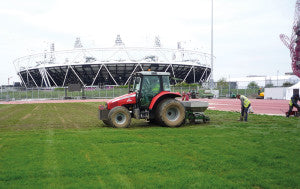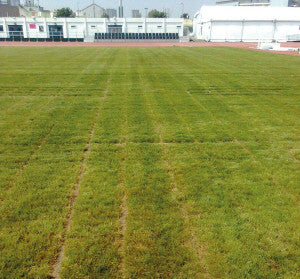Drainage Maintenance for Optimum Performance

Whether it's football, rugby, cricket or golf, the benefits of efficient drainage on any form of sportsturf are evident, but once the work has been carried out maintenance is often forgotten.
Over the years, a perfectly good drainage system can become ineffective if water cannot bridge the gap between the water logged surface and a perfectly functioning pipe system underneath.
Soil compaction is inevitable over time, but there are ways that it can be minimised and they can be very effective. It is advisable to implement a regular basic programme of slitting, verti-draining and hollow coring, which, when done in the right conditions, can help to aerate the soil and reduce the compaction that will compromise any drainage system.
However, even with an excellent maintenance regime, if the soil structure is of poor quality, for example with a high clay content, then drainage can still be sluggish. If this is the case, it may be necessary to renew or implement a secondary drainage system over the top of the primary system which will speed up the flow of excess water much faster than a primary system on its own. This can be done in one of three ways:

Another option is to use a Shelton System 25™ machine which is a versatile mini trencher used primarily for installing a secondary drainage system, over a network of piped drains, in a one pass operation. The System 25™ can also be used to install land drainage pipe and underground services. The trencher cuts a 25mm wide slit, removes the soil and lifts it into a trailer running alongside, whilst the aggregate is simultaneously vibrated into trench. The aggregate can be stopped short of the surface, allowing a free draining sand or root-zone to be placed over the drain run to leave the surface level and ready for play. This system generates fast results, the damage to the turf is minimal and it can be played on 24 hours later.
The third option is Lightning Drain™ which is similar to the System 25™, except the trenches are dug to 35mm wide and a 25mm perforated land drainage pipe is installed prior to backfilling with aggregate. This gives greater longevity and speed to the system as the water travels through the pipe rather than having to percolate through the full length of the trench. The results are immediate and, with good maintenance, including plenty of aeration, the effects will last for years to come.
As an alternative to quarried aggregate, you could consider using Lytag®, a man made material which has many benefits over gravel or crushed stone. Due to its round nature, the flow of water through the material is much greater than that of an angular material as the pore sizes are larger and more even. Its ability to retain water in the drier summer months also minimises the risk of the turf drying out above the drain line which can happen with gravel.

Whatever the surface, green, pitch or fairway, regular maintenance is essential for optimum drainage performance, it really is worth investing the time now and you will reap the benefits for years to come!
Essential drainage maintenance tick list:
- Slitting
- Verti-draining
- Hollow coring
- Sand / rootzone top dressing
- Fertilizer application
Case Study: Smith Construction construct London 2012 Olympics Athletics warm-up area
Smith Construction applied a sand top dressing with excellent results on the London Olympics Athletics warm-up area back in 2012, after installing a secondary drainage system using the Shelton Gravel Band Draining technique.
They had originally installed a primary drainage system over the infield to the warm up track where the javelin, discus and shot putt was held, but the sheer volume of rain which fell during the months leading up the opening ceremony was so great, it was felt that a secondary system should also be implemented to ensure the ground stayed dry and firm and was in peak condition!
The wet conditions were ideal for Gravel Banding as the moist soil could easily be moved sideways by the machines mechanism to allow the Lytag to be vibrated into the band. The application of a sand top dressing over the entire area was the final part of the process and the results were immediate, a free draining surface fit for any medal winning athlete!
